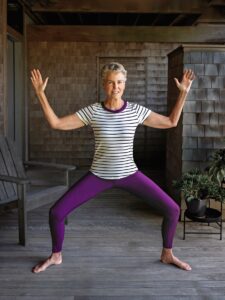Whatever your political preferences, if you are paying any attention these days, you are feeling the unsteadiness of this time. Things feel wobbly. At times like this, for me the question becomes: how can I maintain my equilibrium and clarity of mind to navigate this time with compassion and wisdom? I know that grounding myself is the first thing. I turn to Goddess Pose, Utkata Konasana, for that.
The Sanskrit word utkata means powerful or fierce, kona means angle, and asana, of course, means posture — this is a powerful pose. It strengthens the legs and feet, opens the hips and chest, improves concentration, and clears the mind. And in spite of its name, this is a pose that strengthens the creativity and wisdom in both women and men.
We are learning that what are traditionally called “masculine and feminine energies” don’t actually belong to any one gender. We all can cultivate our nurturing, patient, and intuitive capacities, the part of us that is able to think outside the box. And some part of each of us wants to be action-oriented and make things happen through logic, discipline, or physical strength.
The culture in India, where yoga comes from, still generally holds tight to traditional gender roles. But it’s worth noticing that in the realm of their gods and goddesses, females do have great power. In traditional tales, feminine power is often used to bring things back into balance, to right wrongs, and to heal wounds both physical and social.
The Hindu goddess Kali is depicted as a fierce warrior who symbolizes the strength and power of the feminine side. She is said to have fought off demonic forces to restore justice and peace to the world, and ancient legend has it that after she fought off one particularly demonic figure, Samba, the Earth calmed, the oceans receded, the dark clouds parted, and the sun shone. Goddess Pose is said to invoke the goddess Kali.

To call forth your inner Kali, start by standing in the center of your mat or on another nonslip surface and place your feet three to four feet apart. Turn your feet out at about 45-degree angles. Raise your arms to shoulder height, hands up, fingers pointing to the sky — this is Cactus Arms. Now draw your shoulder blades down your back.
Take a deep breath in and as you exhale bend your knees coming down into a plié or squat. The classic pose is a deep squat with the thighs parallel to the floor, but your pose doesn’t have to be that deep. Your pose depends on your flexibility and strength. To explore your range of motion, go up and down a few times. Draw your tailbone down toward the floor to prevent overextending your lower back. Find a spot where you can stay without too much discomfort.
Here, take the time to be in the pose. Open your chest by lifting the sternum and drawing in the lower ribs. Be sure to maintain a long and straight spine. Lift the muscles below your navel in and up slightly to engage your core. Lift out of your waist. Keep your knees open. The tendency is for the knees to drop forward, but you want to keep them in line with your toes.
If you are having trouble balancing, you can practice this pose standing next to a wall. Keep your arms active, but if the cactus arms position is too hard to hold, you may put your hands on your hips or in front of your chest in Prayer Pose. Imagine your head is like a helium balloon floating up as you keep the back of your neck long. Hold the pose for three or four long easy breaths (you can always go longer or shorter as needed).
To come out of the pose, straighten your knees and heel-toe, heel-toe your feet back to hip width apart. Relax your arms at your sides. Notice how you feel. Each yoga pose will create a resonance in your body. Tune in and feel yours. May you receive the power of Kali to clear the dark clouds and restore peace to the land.



